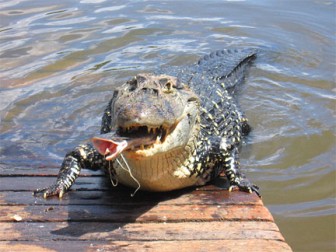Guyana is home to four species of Caiman including the Spectacled Caiman, Black Caiman and two species of Dwarf Caiman; they are classified in the subfamily Alligatoridae and are often mistaken for alligators. The Black Caiman (Melanosuchus niger) is found in Guyana, French Guiana and Amazonia only (not even in Suriname!), and are the largest caiman in the world. Adults can grow up to 6 metres (20 feet) long and as a result, are the largest predator in South American fresh water ecosystems; as adults, they have no natural predators and their prey can include capybara, fish, turtles and deer. However, a full grown Black Caiman is no match for a pack of adult Giant River Otters who have been recorded chasing Black Caiman away from their territory.

Once, Black Caiman were hunted for their skin and unsustainable harvesting and habitat destruction have resulted in their decline. They are now listed as an endangered species by the International Union for Conservation of Nature (IUCN) but maintain a healthy population in the Rupununi River. As they are large predators, they can come into conflict with humans as they rob fishing nets, fish catches from boats and they have been known to prey on domestic dogs that stray too close to the river’s edge.
In Yupukari Village of the North Rupununi, a community group is conducting community research on the ecology of the Black Caiman, catching full-grown adults to weigh, measure and tag them. They also survey ponds in the area to study the nests as well as hatchings and hope to use this information to help develop a management plan for the species.
In December, Black Caiman mound up about 1.5 metres of soil, leaf litter and palm leaves to construct a nest on the edges of ponds and river banks; in this mound, the female lays a clutch of approximately 60 eggs and then buries them inside. The mother Caiman will stay around her eggs, assisting them to break out of their leathery egg shells and then mind the young for several months, guarding them from predators and moving them in her mouth to safer places as Jabiru storks, Arawana, Arapaima, Piranha, turtles and mammals will all prey on the young Caiman. The baby Caiman start eating crustaceans and insects and then quickly graduate to eating fish.
Rain forests are rich in biodiversity and are home to many different plants and animals. In addition, indigenous communities make their homes there. Even if you don’t live in the rain forest, humans rely on the forest for resources such as building materials (wood and lianas), medicine and fruits. Rain forests also provide essential environmental services for life on earth; they create soil as well as prevent soil erosion, produce oxygen though photosynthesis, maintain clean water systems, and are a key defence against climate change.
The Iwokrama Rain Forest is 371,000 hectares, located in the heart of Guyana. Our mission is to develop strategies for conservation and sustainable development for local people in Guyana and the world at large. We are involved in tourism, training, research and our timber is certified by the Forest Stewardship Council. Come and visit us in the rain forest or at http://www.iwokrama.org.





